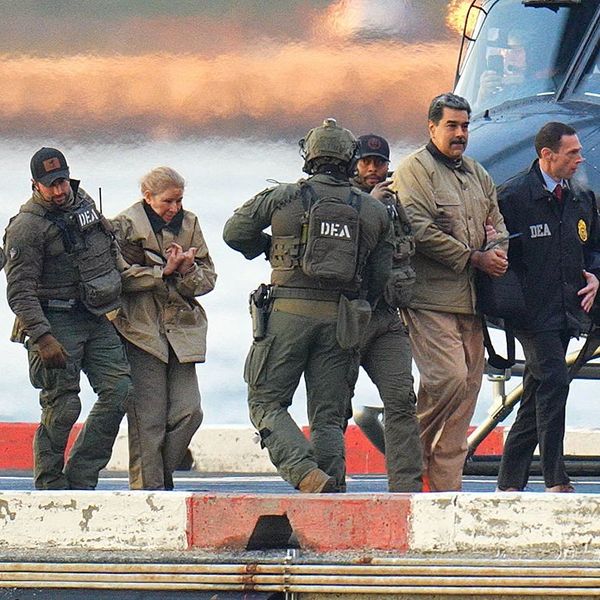OPINION — Like the 1936 - 1939 Spanish Civil War, Russia’s invasion of Ukraine has created a testing ground for the next generation of tactics and weapons to be employed by major powers in future fighting.
At the 1946 Nuremberg trials following World War II, Hitler’s Luftwaffe commandant Hermann Goering said, "Spain gave me an opportunity to try out my young air force.”
On April 26, 1937, 25 German-piloted aircraft accompanied by an equal number of fighter planes, attacked Guernica, a town in northern Spain that was the center of Basque identity and culture. An unprecedented 50 tons of bombs were dropped, and the fighter planes used their machine guns to strafe people in the streets.
Fires burned in the city for three days. Seventy percent of the town was destroyed and some 1,600 civilians—one-third of the population—were killed or wounded. Years later, a secret message back to Berlin was discovered which showed Guernica had served as the testing ground for a new Nazi military tactic: Blanket-bombing a civilian population to demoralize the enemy.
“The chief military lesson of the war has been the terrible moral and material effect on civilians and soldiers of large-scale air bombardments,” was a quote former Maj. Gen. A.C. Temperley used in his article Military Lessons of the Spanish War in the October 1937 issue of Foreign Affairs. Temperley, a former Deputy Director of Military Operations and Intelligence in the British War Office, added, “More and more are aircraft deciding campaigns, but the intense use of aircraft is only quite recent.”
Needless to say, within a few years, strategic bombing played a major role in World War II.
Think of the London Blitz by Germany in the early 1940s to break the will of the British people, and later, American heavy bombing of Berlin and Tokyo to try to get the Germans and Japanese to surrender.
Now, Russian President Vladimir Putin is trying a new form of strategic air warfare against the Ukraine civilian population using cruise missiles and drones to try to turn the tide while his troops have been losing in ground warfare.
Since Ukraine’s military gains in the Donbas region and its October 8 attack on the Kerch Bridge linking Russia to Crimea, Moscow has been striking Ukraine’s power stations, water supply systems and other key infrastructure across the country.
Last Saturday, 1.5 million Ukrainians temporarily were left without electricity from what Ukraine President Volodymyr Zelensky said was “a massive attack” from 36 Russian missiles.
With cold weather arriving and a harsh winter expected to follow, Zelensky last Thursday announced that one-third of Ukraine’s power stations have been knocked out and pleaded with his people to consume less power. The national electric utility, Ukrenergo, said last Thursday that the grid had suffered more attacks in 10 days than in the previous seven and a half months of war.
Ukraine civilians are already struggling with rolling blackouts and scattered shortages of clean water. As The New York Times put it last week, “Russia has stepped up its bombardment of Ukraine, focusing on civilian infrastructure deep inside the country — an apparent attempt to break the country’s ability and will to fight — rather than on the front lines, where its military has been losing ground for more than a month.”
Putin’s plan may be to use the winter to train his 300,000 new conscripts and start a fresh offensive when spring comes against a demoralized Ukrainian people who had suffered through a cold and dark several months.
One interesting point: Back on April 12, 2022, just after the invasion began, Russian hackers unsuccessfully targeted Ukraine’s electric power grid in an attempt to cause a blackout that would have affected two million people, according to Ukrainian government officials. It failed, as have most other cyberattacks, because Ukraine had joined together with U.S. and other allied experts to create a workable cyber defense.
Back in the 1936 Spanish Civil War, German and Italian forces aided the pro-fascist, anti-Spanish government rebels of Gen. Francisco Franco by introducing new methods of tank warfare, which Hitler and Mussolini would then use for initial gains at the start of World War II.
However, as Maj. Gen. Temperley pointed out back in 1937, the Fascist side’s use of tanks brought forward “a new phenomenon” from the Spanish Government military supporters “in the shape of the anti-tank gun.” The U.S. military attaché in Madrid at the time, Col. Stephen O. Fuqua, reported his focus had become tanks, anti-tank, and anti-aircraft weapons.
In the Ukraine early fighting, Russian tank formations were met with small, U.S. Special Forces-trained, fast-moving Ukraine units armed with American Javelin anti-tank weapons. The Javelin has a capability after launch to be able to track and destroy its target without further assistance from the gunner. It has an onboard imaging system and a tracking system that locks on to the targeted tank, even if it moves.
Some Javelins have a direct line aiming capability, while others have the ability for the weapon to climb sharply after launch, cruise at a high altitude and dive down at the top of the targeted tank, which is the weakest defensive section of a Russian, or any tank.
Heavy artillery was not a major factor in the Spanish Civil War, but it became a big part of the Russian Ukraine invasion after Moscow pulled back from going after Kyiv. With static fighting batteries in the Donbas area, Russian troops were able to make gains helped greatly by heavy artillery units far back from the front lines.
Enter the American High Mobility Artillery Rocket System (HIMARS) launcher, a five-ton truck that can carry and then fire, a single six-pack of Guided Multiple Launch Rocket System (GMLRS) rockets. The GMLRS single, solid-fueled rocket carries a 200-pound warhead which provides a GPS-guided, precision strike at point targets at a range of more than 40 miles.
The HIMARS launcher can be quickly set up to fire in a few minutes. Rockets fired one at a time or in salvo, the launcher is ready to drive away within less than five minutes, thus being able to avoid being targeted by the enemy. It also has a unique, self-loading, pod feature unlike any other rocket artillery system.
The HIMARS launcher and GMLRS rockets were successfully combat tested during Operation Iraqi Freedom. Using location intelligence from satellites, drones, and electronic intercepts, the HIMARS system has accurately hit behind-the-lines Russian fixed artillery batteries, command and control centers, ammunition dumps and other supply points and thus has been a major reason for recent Ukraine military gains.
Subscriber+Members have a higher level of access to Cipher Brief Expert Perspectives on Global Issues. Upgrading to Subscriber+ Status now.
As a sign of Pentagon support for the HIMARS program, on October 11, the Army awarded a no-bid, five-year contract to Lockheed-Martin to continue providing logistics such as depot repair to all components of the HIMARS system beginning in January 2023.
Among the other new American weapons being used in Ukraine are:
- The British-developed, but American-made, M777 lightweight, howitzer that can fire five 155 mm artillery rounds per minute at targets 20 miles away and “shoot and scoot” before being targeted. It can also fire a new, GPS-guided, M982 Excalibur round with deployable stabilizing fins that can hit within approximately 250 to 500 feet of a target 25 miles out.
- The GM-88 high-speed anti-radiation missile (HARM) is a 1980s-designed, air-to-surface tactical missile that seeks and destroys enemy radar-equipped air defense systems. Ukraine spokesmen have said their use of HARM missiles has allowed Ukrainian Air Force strike planes to blitz Russian ground forces. In addition, the threat HARM missiles pose can force Russian radar operators to turn off their sets and lie low. Ukraine’s air force, as a result, may not quite fly with impunity, but it has greater freedom than before.
- Tactical, military kamikaze drones such as the Switchblade 300 and Switchblade 600 as well as the newer Phoenix Ghost. They were first developed to counter insurgents in Afghanistan, but the Switchblades have become a part of the U.S. military’s conventional and Special Operations weaponry.
- The Switchblade 300 weighs just over five pounds, carries an explosive charge the size of a Claymore mine, is launched like a mortar and has a very short operational range of only 15 minutes or six miles. The operator looks for a target with the munition’s camera. Once spotted, the Switchblade can loiter while the operator figures out the best spot to strike.
- The Switchblade 600, still considered in the prototype phase, carries a more powerful anti-armor payload similar to the Javelin warhead, weighs in at 30 pounds and has a 40-minute or 24-mile loiter time. As with the smaller version, it is to be used by soldiers very close to the frontlines.
- The Phoenix Ghost, the newest of these smaller, one-way drones, has a six-hour loitering time and infra-red guidance that permits night attacks. Its warhead power is said to be between that of the Switchblades, but enough to destroy a tank.
The prospect that modernized U.S. weaponry would be supplied to Ukraine did not deter President Putin from invading that country eight months ago. But those weapons are helping the Kyiv government halt and push back the Russian forces. Perhaps this lesson on American weapon deployments will deter some future foreign leader from starting another war.
Read more expert-driven national security insights, perspective and analysis in The Cipher Brief











